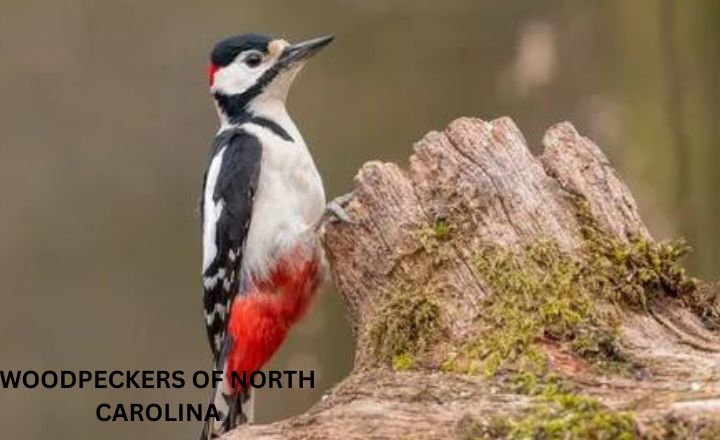North Carolina’s lush forests resonate with the rhythmic drumming of woodpeckers, captivating both bird enthusiasts and nature lovers alike. Woodpeckers Of North Carolina grace the skies and trees of this southern state; each woodpecker brings its unique charm and character to the landscape.
Join us as we examine these fascinating avian residents, uncovering their habits, habitats, and intriguing behaviors that make them an integral part of North Carolina’s natural tapestry. Embark on a journey through the wooded realms of North Carolina and discover the diverse world of Woodpeckers Of North Carolina that call this state home.
Downy Woodpecker

Downy Woodpecker
One of the most distinctive Woodpeckers Of North Carolina is the Downy Woodpecker (Picoides pubescens). This small and charming bird features prominent black and white markings, with a touch of red on their head for males. Their diminutive size, Downy Woodpeckers are skilled drummers, using their beaks to create loud hammering sounds while foraging for insects beneath tree bark.
When observing woodpeckers in North Carolina, the Downy Woodpecker stands out due to its subtle but elegant appearance. Its feather patterns provide excellent camouflage against tree bark, making it blend seamlessly into its woodland habitats. These birds have a distinct call that resonates through the forests of North Carolina, adding a melodic element to the natural symphony of bird songs.
Range
The Downy Woodpecker of North Carolina is a small but vibrant bird. Known for its distinctive black-and-white plumage and tiny size, this woodpecker species is common in forests, parks, and even suburban areas across the state.
The Downy Woodpecker’s range in North Carolina spans from the mountains to the coast, making it a versatile and adaptable species. As one of the most widespread woodpeckers in North America, the Downy Woodpecker adds life and color to North Carolina’s natural environment with its cheerful calls and energetic behavior.
Diet and Foraging Habits
The Downy Woodpecker, commonly found in North Carolina, has a diverse diet that consists of insects, seeds, and sap. These adept foragers have a unique hunting technique where they use their strong beaks to drill into tree bark to find hidden insects like beetles and grubs. Their ability to extract insects from wood allows them to thrive in various forested environments. By controlling insect populations through their feeding practices, these woodpeckers contribute to the overall health of forests by reducing pest numbers that could potentially harm trees.
Sorrow and melancholy are also prevalent in Shayari. Poets often reflect on pain and loss. They express their grief and loneliness. This type of Shayari resonates deeply with those who have faced hardship. It provides solace and understanding. Sorrowful Shayari often speaks of unfulfilled desires and broken hearts. It can be a source of comfort. Readers find their own pain mirrored in these verses.
Where to Find This Bird
One of the best places to spot Downy Woodpeckers is in North Carolina, particularly in the wooded areas and forests rich with mature trees. These small but striking birds are known for their distinctive black and white plumage, making them easily recognizable amidst the green foliage. If you wander through parks or nature reserves in North Carolina, watch for these agile climbers as they search for insects on tree trunks.
Hairy Woodpecker

Identification
As you explore the woodlands of North Carolina, keep an eye out for the distinctive Hairy Woodpecker. Known for its striking black and white plumage, this woodpecker can be easily identified by its long, chisel-like bill and bold red patch on the back of its head. Although its appearance is similar to that of the Downy Woodpecker, the Hairy Woodpecker is larger and has a longer bill. It is a very beautiful bluebird in California. Highlighting Two distinct species that call this captivating habitat home.
Range
The Hairy Woodpeckers Of North Carolina can be spotted in wooded areas across the state, from the mountains to coastal regions. Known for its loud call and distinctive pecking sound, this woodpecker plays an important role in maintaining forest ecosystems by controlling insect populations. Found throughout most of North America, from coast to coast, the Hairy Woodpecker prefers mature forests with plenty of dead trees for foraging.
Diet and Foraging Habits
The Hairy Woodpecker is a masterful forager, using its chisel-like bill to extract insects from tree bark precisely. Despite its name suggesting a diet of mainly wood, these woodpeckers have a diverse palate that includes beetles, caterpillars, ants, and even the occasional fruit or seed. In North Carolina, the Hairy Woodpecker can be spotted diligently exploring trees for sustenance throughout the year. They drum on dead branches to flush out hidden insects and use their long tongues coated with sticky saliva to secure their prey.
Where to Find This Bird
The Hairy Woodpecker is a striking bird in North Carolina, with its distinct black and white plumage and long, sturdy bill. These striking birds can be found in various habitats across the state, including coniferous and mixed forests, where they forage for insects on trees using their powerful bills.
One of the best places to find Hairy Woodpeckers in North Carolina is the mountain regions, where mature forests provide ample food sources and nesting sites. Look for these skilled excavators as they search for beetles and ants under tree bark or hammer away at dead wood, looking for hidden insects.
Northern Flicker
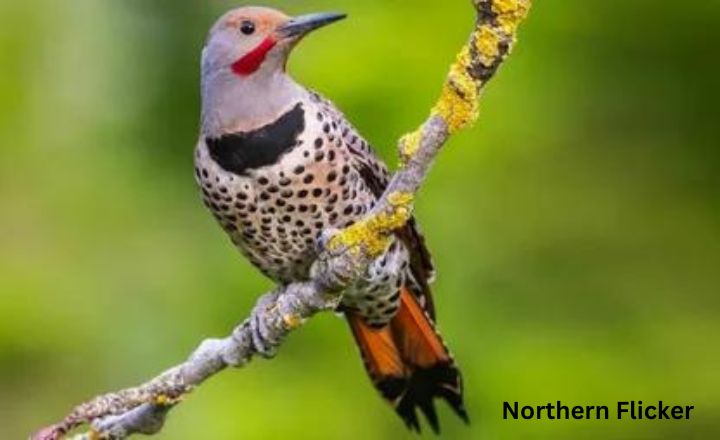
Identification
Identifying northern flickers among the woodpeckers in North Carolina can be a fascinating challenge for birdwatchers. These medium-sized birds stand out with their distinct appearance, unique markings, and behavior. The key characteristic of a northern flicker is its prominent black bib and spotted belly, with a brown back and wings adorned with bold black bars.
One way to differentiate the Northern Flickers from other woodpeckers in North Carolina is by observing their habits. Unlike most woodpeckers, Northern Flickers spend considerable time on the ground foraging for insects, making them skilled hunters both in trees and on the forest floor. Their distinctive call—often described as a loud wick-a-wick-a-wick sound—sets them apart from other avian species in the area. Their distinctive behavior and appearance make spotting a Northern Flicker in North Carolina an exciting challenge that promises an unforgettable birdwatching experience.
Range
The Northern Flicker is a striking woodpecker species found in North Carolina, adding a vibrant and dynamic presence to the state’s avian population. Their range extends across North America, showcasing their adaptability and resilience in various habitats. While many woodpeckers primarily reside in forests, the Northern Flicker can also be spotted in open areas like fields, parks, and even backyards.
In North Carolina, birdwatchers are often delighted by the sight of these charismatic birds foraging for insects on the ground or drumming on tree trunks with the rhythmic beat. As these beautiful creatures navigate through the diverse landscapes of North Carolina, they serve as charming ambassadors of nature’s wonders.
Diet and Foraging Habits
Unlike traditional woodpeckers, which primarily feed on insects by drumming on trees, the Northern Flicker prefers to forage on the ground for ants and beetles. This behaviour is unusual for a woodpecker, showcasing its versatility and adaptability in finding food sources. The Northern Flicker also enjoys dining on fruits and seeds, making it more of a generalist feeder than its woodpecker counterparts. Its diverse diet reflects the bird’s ability to thrive in various habitats and environments.
Where to Find This Bird
If you want to find this bird, head to wooded areas with plenty of open spaces, such as parks, forests, or residential areas with large trees. Keep an eye out for their unique flight pattern – a mix of flapping and gliding that sets them apart from other woodpeckers in NC. One great place to look for Northern Flickers is the Great Smoky Mountains National Park, where their loud calls and striking plumage make them stand out against the lush greenery. keep an ear out for their distinct drumming sounds as they search for insects beneath the bark of trees.
Pileated Woodpecker
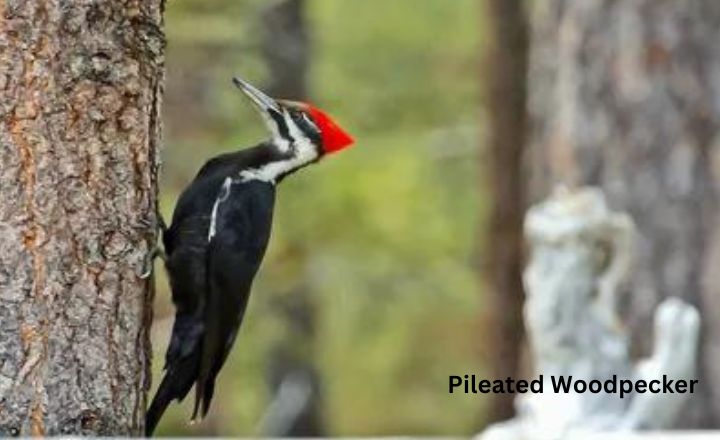
Identification
The Pileated Woodpecker, known for its striking black body and vibrant red crest, is the largest woodpecker species in North Carolina. Identifying these majestic birds is relatively easy due to their distinctive appearance and unique drumming sounds that echo through the woods. Unlike other woodpeckers in NC, the Pileated Woodpecker has a distinct long neck and a powerful bill designed for excavating large holes in search of insects.
One key feature to look out for when identifying these North Carolina woodpeckers is their loud calls, described as a series of sharp kuk-kuk-kuk or waka-waka-waka sounds. their white stripes on the face and bold white wing patches make them stand out against the backdrop of dense forests where they typically reside.
Range
The Pileated Woodpecker, one of the largest woodpeckers in North America, can be found across a vast range stretching from the eastern United States to parts of Canada. While these striking birds are commonly seen in mature forests throughout their range, they particularly thrive in areas with large trees and ample deadwood for foraging. In North Carolina specifically, the Pileated Woodpecker is a familiar sight with its distinctive red crest and loud hammering echoing through the forest.
Diet and Foraging Habits
The Pileated Woodpeckers Of North Carolina, a majestic bird found in the forests has a fascinating diet and foraging habits. These woodpeckers feed on insects like carpenter ants and wood-boring beetles in decaying trees. With their powerful beaks, these Large Woodpeckers can effortlessly dig into tree bark to uncover their prey. These large woodpeckers also enjoy dining on fruits and nuts such as berries and acorns. They are known to drum loudly on dead trees, not only to find food but also to establish territories and attract mates.
Where to Find This Bird
When spotting the impressive Pileated Woodpecker in North Carolina, there are a few key areas where you’re more likely to catch a glimpse of this majestic bird. One popular location is the Great Smoky Mountains National Park, particularly along the Cades Cove Loop Road, where these woodpeckers can often be seen drilling into trees in search of insects and larvae.
Another hotspot for pileated woodpeckers is the Pisgah National Forest, especially near old-growth forests with plenty of dead or decaying trees that are perfect for foraging. Look for Pileated Woodpeckers in other wooded areas around North Carolina, such as Umstead State Park and Eno River State Park.
Red-bellied Woodpecker
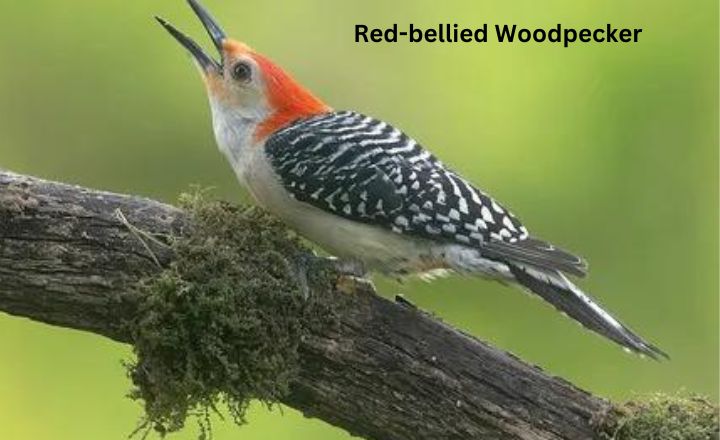
Identification
The Red-bellied Woodpecker (Melanerpes carolinus) is a striking bird species commonly found in North Carolina. Its name can be misleading, as the red patch on its belly is often invisible unless the bird is upside-down. One key identification feature of this woodpecker is its zebra-like black and white stripes on its back, complemented by a vibrant red cap on top of its head.
In North Carolina, birdwatchers can easily spot Red-bellied Woodpeckers due to their loud calls and distinctive drumming sounds. their unique pattern of black and white feathers provides excellent camouflage as they forage through wooded areas.
Range
The Red-bellied Woodpecker in North Carolina can be found year-round in the state’s forests and woodlands. Its range extends beyond what its name suggests. The Red-bellied Woodpecker, found in North Carolina and other parts of the southeastern United States, boasts a range that extends beyond what its name suggests. their name, these woodpeckers have a small patch of reddish colour on their bellies rather than a predominant red hue.
Diet and Foraging Habits
Regarding foraging habits, Red-bellied Woodpeckers are known for their agile climbing skills and unique feeding methods. They use their strong bill to drill holes in tree bark or probe crevices to uncover hidden insects or extract sap. While insects make up a significant portion of their diet, especially during the breeding season when protein is crucial for young birds’ growth and development, they also enjoy feasting on berries and seeds. This variety in their diet allows them to adapt to different food sources depending on the season and availability.
Where to Find This Bird
The Red-bellied Woodpecker, with its vibrant plumage and distinctive zebra-backed appearance, can be found throughout the eastern United States, including North Carolina. This adaptable bird is commonly spotted in mature forests, wooded neighborhoods, and stands of trees near water sources. Look for its characteristic drumming sounds as it searches for insects in tree bark, or listen for loud calls echoing through the treetops. These birds are known to frequent bird feeders stocked with sunflower seeds or suet cakes.
Red-cockaded Woodpecker
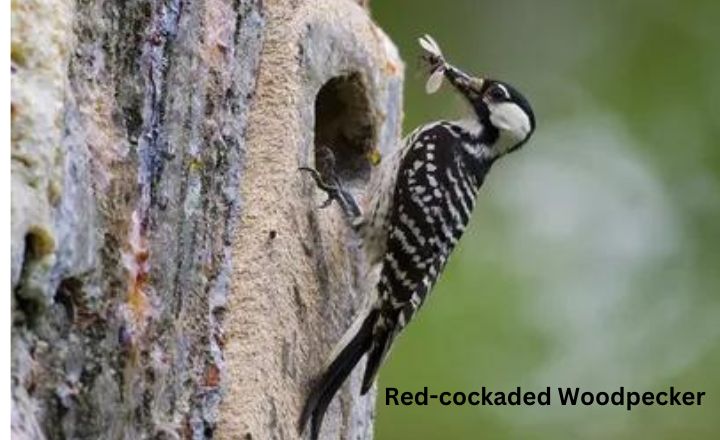
Identification
The red-cockaded woodpecker, known for its small size and striking black-and-white plumage, is a unique species found predominantly in the pine forests of North Carolina. What sets this woodpecker apart from others is its distinct red cockade, or strip of feathers behind the eyes of adult males, making it easily recognizable in the wild.
This feature is a key identifier for birdwatchers and researchers when spotting these elusive birds among the trees. Identifying red-cockaded woodpeckers can be challenging due to their camouflaged coloration that blends seamlessly with tree bark
Range
the range of the Red-cockaded Woodpecker continues to shrink due to urban development and logging activities. Maintaining a healthy population of these woodpeckers is essential for preserving biodiversity and supporting ecosystem health in the region. Wildlife enthusiasts aim to promote sustainable coexistence between humans and these iconic birds in North Carolina by protecting their habitats and creating corridors between fragmented forests.
Diet and Foraging Habits
The Red-cockaded Woodpecker’s diet primarily consists of insects such as beetles, ants, and caterpillars. Its foraging habits are unique in that it often consumes insects by peeling off the bark from pine trees with its powerful bills. It spends most of its time foraging on mature pine trees, searching for its preferred prey hidden beneath the bark.
These woodpeckers have developed a specialized feeding technique called ‘pitching,’ where they create sap wells on pine trees to attract insects. This behavior provides them with a food source and helps sustain other wildlife in their ecosystem.
Where to Find This Bird
The Red-cockaded Woodpecker, an elusive and endangered species, is mainly found in longleaf pine forests across the southeastern United States. In North Carolina, these woodpeckers can be spotted in places like the Uwharrie National Forest and Croatan National Forest.
Due to their unique nesting habits in live pine trees, locating a red-cockaded woodpecker often involves searching for clusters of old-growth pines with distinctive sap wells around the trunks. These birds are particularly fond of mature pine savannas and open woodlands with a sparse understory.
Red-headed Woodpecker

Identification
Pay attention to its behavior when identifying a Red-headed Woodpecker in North Carolina. Unlike other woodpeckers that primarily forage on tree trunks, the Red-headed Woodpecker often catches insects mid-air or searches for food on the ground. One distinguishing feature of the Red-headed Woodpecker is its vibrant redhead, which contrasts sharply with its sleek black and white body. This woodpecker also has a clean white belly and bold black wings with large white patches visible.
Diet and Foraging Habits
The Red-headed Woodpecker, a stunning bird in North Carolina, has an eclectic diet, including insects, fruits, nuts, and seeds. Known for its unique hunting style, this woodpecker catches insects mid-air and stores food in tree crevices for later consumption. When foraging for food, Red-headed Woodpeckers exhibit impressive acrobatic skills as they cling to tree trunks and branches while searching for their next meal.
Diet and Foraging Habits
When it comes to foraging, Red-headed Woodpeckers showcase impressive skills. They have a distinctive style of hunting where they catch insects on the wing or pry them from tree bark with their strong beaks. This dynamic approach to feeding sets them apart from other woodpecker species and highlights their intelligence and agility in finding food. These striking birds have a varied menu, feasting on insects, fruits, nuts, seeds, and even small vertebrates like frogs and mice.
Where to Find This Bird
The Red-headed Woodpecker, a striking bird with bold red, white, and black colours, is a sight for birdwatchers in North Carolina. These woodpeckers are often found in open woodlands, orchards, and parks, where they can be spotted darting between trees for food. One key feature that sets the Red-headed Woodpecker apart is its unique foraging habits.
Red-headed woodpeckers drill into tree bark for insects like many other woodpeckers do; these birds are known to catch flying insects mid-air or even store food in tree crevices or fence posts to eat later. When it comes to finding sustenance in various environments, for those keen on encountering this beautiful species up close, exploring wooded areas with a mix of mature trees and open spaces may yield sightings of this elusive yet fascinating bird.
Yellow-bellied Sapsucker
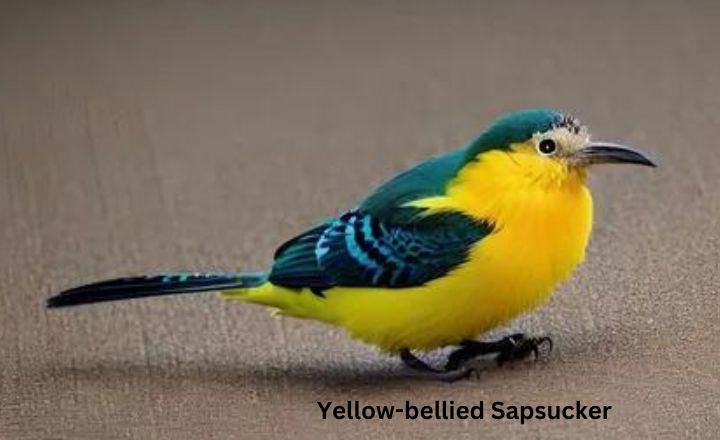
Identification
The Yellow-bellied Sapsucker is a unique woodpecker species found in North Carolina. Its distinctive black and white plumage can easily identify it with a bright red crown and throat patch. What sets this bird apart is its penchant for drilling neat rows of small holes in trees to extract sap, earning it the nickname Sapsucker.
This unique feeding behavior not only sustains the sapsuckers but also benefits other wildlife that may feed on the insects drawn to the sweet liquid.
Range
Yellow-bellied Sapsuckers are most commonly spotted in mixed forests and wooded areas, where they feed on sap by drilling holes in trees with their specially adapted bills. These woodpeckers have a relatively wide range across North America, including parts of eastern Canada and the southern United States.
In North Carolina specifically, they can be observed throughout different state regions, making them a common sight for locals and visitors alike. Their presence reminds people of the rich biodiversity in North Carolina’s ecosystems, offering a glimpse into the intricate balance of nature within this region.
Diet and Foraging Habits
Yellow-bellied Sapsuckers often create distinct patterns of holes in trees known as sap wells, which serve as their feeding stations. While primarily feeding on tree sap by drilling small holes in the bark, they also consume insects attracted to it, making them efficient insect hunters. This dual feeding strategy allows them to obtain energy-rich sap and protein-packed insects, ensuring a balanced diet.
Where to Find This Bird
The Yellow-bellied Sapsucker, with its distinctive black and white plumage and bright red throat, is a fascinating bird to observe in the wild. One of the best places to find this species is in mature forests with a mix of deciduous and coniferous trees, particularly in North America during the breeding season. These birds can be spotted in various habitats, including woodlands, orchards, and even suburban areas with suitable trees for drilling sap wells.
Summary
Woodpeckers Of North Carolina (8 Species To Know) with unique characteristics and behaviours. By familiarizing ourselves with these eight species, we can gain a deeper appreciation for the important role woodpeckers play in our ecosystem. You spot the striking red head of the Red-bellied Woodpecker or hear the distinctive drumming sound of the Pileated Woodpecker. These birds are a fascinating and integral part of North Carolina’s natural heritage. Take some time to explore the forests and woodlands of North Carolina to catch a glimpse of these remarkable creatures in their natural habitat. Let’s continue to protect and preserve the habitats that sustain these magnificent woodpeckers for future generations.


